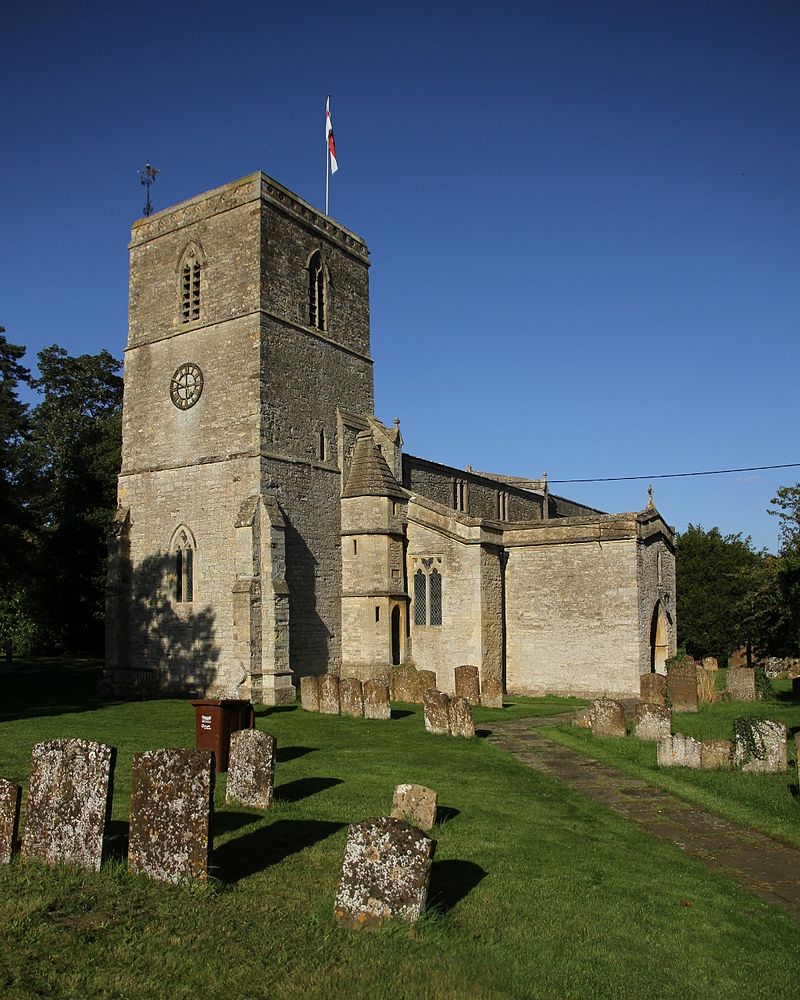Arthur Mee - The King's England, Oxfordshire
Chesterton – On a Roman Road.
 The Roman Akeman street runs through it, and a mile away are the remnants of the Roman town of Alchester, mounds with buried history. Round about the clerestoried church are fine trees, among them a splendid yew shading a space 180 feet round. There is a 15th century tower with a 19th century turret, and a doorway in the lofty porch a century older than the tower. Much fine work is within: a splendid tower arch without capitals; a 12th century arcade on scalloped capitals, and 13th century arches on imposing round pillars. The beautiful chancel arch has a delicate column on either side, and capitals carved with leaves and tendrils 700 years ago. In the chancel are three magnificent stone seats, with detached columns between their arches, and ballflower in the fine tracery, 14th century work at its best.
The Roman Akeman street runs through it, and a mile away are the remnants of the Roman town of Alchester, mounds with buried history. Round about the clerestoried church are fine trees, among them a splendid yew shading a space 180 feet round. There is a 15th century tower with a 19th century turret, and a doorway in the lofty porch a century older than the tower. Much fine work is within: a splendid tower arch without capitals; a 12th century arcade on scalloped capitals, and 13th century arches on imposing round pillars. The beautiful chancel arch has a delicate column on either side, and capitals carved with leaves and tendrils 700 years ago. In the chancel are three magnificent stone seats, with detached columns between their arches, and ballflower in the fine tracery, 14th century work at its best.
The Norman font, surrounded by a Jacobean screen of richly carved arcading, has an elaborate canopy of iron work nine feet high, fitted with a balance gear, and with candle-holders at each side. Many finely wrought candelabra remain to remind us of the church’s old-time services by candle light.
There are 17th century portrait brasses of William Maunde carrying a sword and wearing cloak an knee-breeches, and of his wife in a gown with a hooped skirt, pointed bodice, and high hat.
The chancel has a delightful medley of woodwork brought from Brittany and set up here by the village carpenter. There are elaborately carved 17th century oak panels, and an oak reredos rich with wheel and baluster ornament. Similar panelling forms a screen by the south door, and has on it a figure of a priest, carved in 1644. There are fine old moulded beams in the nave roof, and the pulpit has richly traceried old panels.
W. Hobart Bird – Old Oxfordshire Churches.
The church of St. Mary stands in a very spacious church-yard surrounded by fine trees. The church comprises quire, clerestoried nave and aisles, South porch and an open quatrefioled parapet. The porch has an upper chamber with a trefoiled lancet light.
The lofty quire has a restored Early English priest’s door with a shouldered arch. There is an interesting old finial cross on the East gable and a blocked Early English North doorway. The inner doorway of the porch is 14th century with continuous chamfered arch, rounded abaci and label. The nave arcade of three bays is Transitional Norman on the North, with cylindrical pillars, square scallop capitals and abaci, with slight chamfer to the arches. The South has typical Early English with tall cylindrical pillars, round moulded capitals and bases, and arches of two chamfered orders. Note the old corbels to nave roof.
The interesting chancel arch is good Early English, with slender shafts to responds, which have good sculptured capitals of conventional stiff-stalk ornament, and a chamfered arch of two orders. The quire has on the South late Decorated windows with very good and interesting tracery of flamboyant type in rere arches. The tracery of the East window is new. There is a low-side window in deep splay. The rectangular piscina and credence originally had a door in order to serve also as the ambury: this is unusual. Note the beautiful Decorated triple sedilia with slender detached moulded shafts to the cinquefoiled arches, which have ball-flower ornament and large ball-flower finials. Note the remains of ancient painting on the spandrels of the arches. There is a low-side window in a deep splay, and an Early English lancet, which is rebated for an oak shutter externally. Near the chancel arch on the North side is a great rectangular opening on moulded brackets: its purpose is uncertain.
The good oak pulpit has traceried panels. Note also the old oak reredos, said to have come from Brittany, the old nave roof and corbels, and the two image brackets at the East end of the aisle denoting a previous altar there. The North arcade is Transitional Norman with cylindrical pillars. The South is Decorated with lofty arches. The fenestration is Decorated and Perpendicular. At the West particularly note the interesting “Baptistery”, which has the old cylindrical font enclosed within a heavy low carved oak Jacobean screen. The font cover has the most elaborate iron framework and balance gear, and incorporated in it, two ornate extending arms for candelabra, quite unique.